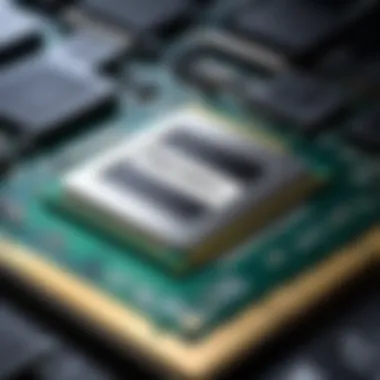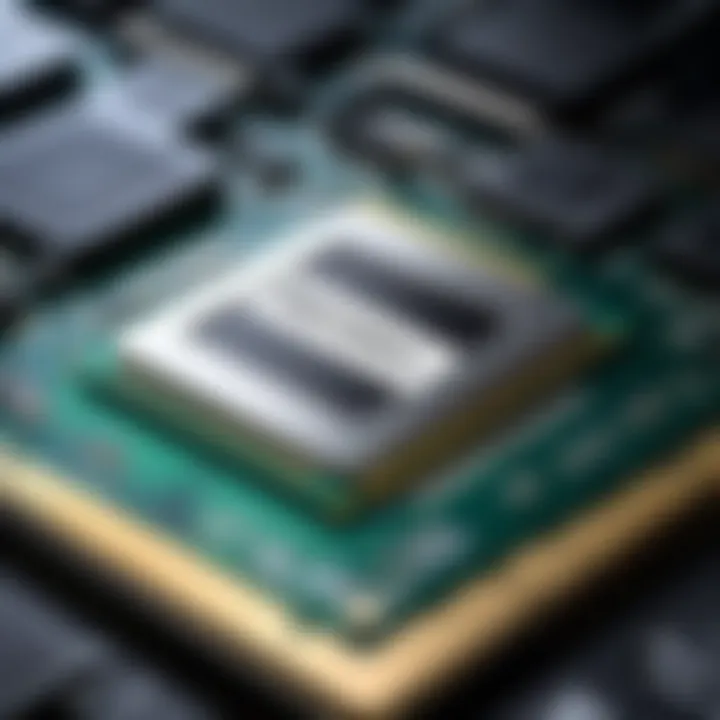Essential Specifications for Video Editing Laptops


Intro
In today's digital age, the demand for high-quality video content continues to surge. This growth places significant importance on the tools used for video editing, which hence requires serious consideration. For IT professionals and tech enthusiasts, selecting the right laptop becomes more than just choosing a catchy model or a popular brand. It involves an in-depth understanding of the specific specifications that can make or break the efficiency of video editing tasks. This article aims to guide readers through the crucial specifications necessary for selecting a laptop suited for video editing.
Product Overview
Key Features
When evaluating laptops for video editing, several key features stand out. These include:
- Processor: Often referred to as the brain of the laptop, the processor significantly impacts performance in handling video files. Higher clock speeds and multiple cores facilitate smoother editing processes.
- RAM: Adequate memory is crucial for multitasking and running resource-intensive applications. Anywhere from 16GB to 32GB is generally recommended for seamless performance.
- Storage: Choosing between Solid State Drives (SSD) and Hard Disk Drives (HDD) is essential. SSDs offer faster data transfer rates and quicker boot times.
- Display Quality: A high-resolution display with accurate color reproduction helps editors see their work as intended. Look for laptops with at least 1080p resolution.
- GPU Capabilities: A robust Graphics Processing Unit (GPU) is necessary to handle rendering and effects in video editing software.
Technical Specifications
In addition to key features, understanding the technical specifications is essential. Consider the following:
- Processor Types: Intel Core i7, i9 or AMD Ryzen 7, 9.
- RAM Options: Minimum 16GB, expandable to 32GB or more.
- Storage Types: 1TB SSD or a combination of high-capacity HDD for storage and SSD for performance.
- Display Specs: IPS panels for better colors, with options for 4K resolution.
- GPU Options: NVIDIA GeForce RTX or AMD Radeon RX series.
"When choosing a laptop for video editing, never underestimate the significance of each component. They work together to ensure a smooth editing experience."
Performance Analysis
Benchmark Test Results
Benchmark tests offer valuable insights into real-world performance. Software such as Cinebench or PassMark provides metrics that help compare processors and GPUs. For instance, an Intel Core i9 processor typically scores higher than an i7 in multi-core tasks, which is crucial for rendering video.
Real-World Usage Scenarios
Understanding how specifications translate into real-world productivity is vital. For instance:
- High-Resolution Video Editing: A laptop with 32GB of RAM and an NVIDIA GeForce RTX 3060 can handle 4K video files smoothly without lag.
- Multitasking: Editing while simultaneously running a video preview requires substantial RAM and a high-performance processor. Ideally, 32GB RAM works best in these scenarios.
With the right specifications, video editing becomes a more efficient process, enabling content creators to focus on their creativity rather than technical limitations.
Prologue to Video Editing Laptops
The realm of video editing demands a unique set of tools and specifications. Choosing the right laptop is crucial for achieving optimal performance. Video editing requires significant processing power, high-quality graphics, and ample storage. These factors not only affect the speed of rendering and exporting projects but also enhance the overall editing experience.
When engaging in video editing, professionals and enthusiasts alike must understand the importance of hardware specifications.
Importance of Choosing Correct Hardware
- Processor Performance: The CPU is the heart of a laptop. A powerful processor can reduce the time needed for rendering and compiling videos. Processors from Intel and AMD offer varying levels of performance that can satisfy different editing needs.
- RAM Requirements: Sufficient memory is essential for smooth multitasking. When editing videos, it is beneficial to have at least 16GB of RAM to handle multiple applications simultaneously without slowdowns.
- Storage Solutions: Fast and reliable storage impacts how quickly files can be accessed and written. Solid-State Drives (SSD) outperform Hard Disk Drives (HDD) when it comes to speed, making them ideal for video editing.
- Graphics Capability: The graphics card also plays a vital role in how edited videos appear on screen. Dedicated GPUs from NVIDIA or AMD ensure better rendering and playback performance compared to integrated solutions.
- Display Quality: Having a high-resolution display with accurate color representation is necessary for video editing. A good screen allows for better editing precision and helps in achieving desired visual effects correctly.
"Selecting an appropriate laptop can significantly influence your workflow and the quality of your final product."
In summary, selecting a laptop for video editing is not just about preference; it involves understanding specific hardware requirements that cater to video editing tasks, thus ensuring efficiency and enhancing creative expression.
Importance of Hardware Specifications
When considering a laptop for video editing, the importance of selecting the right hardware specifications cannot be overstated. The performance of video editing tasks, from rendering to exporting, relies significantly on the components within the machine. If you aim to work efficiently, understanding these specifications is crucial.
Impact on Performance
The relationship between hardware specifications and performance in video editing is direct. A powerful processor, for example, can drastically reduce rendering times. Video editing software often utilizes multiple cores for processing, which means having a multi-core CPU is advantageous. When your CPU can handle multiple threads, you can edit video in real-time without lagging or delays.
Other factors, such as RAM, also play a vital role in performance. Insufficient RAM can lead to system crashes or slow performance, especially when working with large files or running multiple applications simultaneously. This is why memory capacity, usually between 16GB and 32GB, is often recommended for serious video editors.
Additionally, the choice of storage technology matters. An SSD can significantly enhance read and write speeds when compared to a traditional HDD. Faster access to files facilitates smoother editing workflows, allowing users to concentrate on creativity rather than technical restrictions.
Aligning Specs with Software Requirements
Every video editing software has its own set of recommended specifications. For instance, Adobe Premiere Pro, a popular choice among professionals, suggests a minimum of 8GB of RAM but recommends 16GB for better efficiency. It also leverages the power of the GPU for rendering tasks, which highlights the importance of a dedicated graphics card.
It is essential to align your laptop specifications with the requirements of the software you intend to use. Each software demands different levels of processing power, memory, and graphical capability. When specifications are mismatched, you may face issues like slow rendering times, crashes, or sub-par performance.
Processor Considerations
Selecting the right processor is crucial when choosing a laptop for video editing. The processor acts as the brain of the computer, executing tasks needed for rendering, transcoding, and other intensive editing processes. A powerful processor ensures that these tasks can be completed efficiently, reducing loading times and improving overall workflow. Understanding processor specifications can help users make an informed choice that aligns with their editing needs.
CPU Types and Brands
Intel vs. AMD
When comparing Intel and AMD, both brands offer processors with unique strengths. Intel has long been the go-to choice for many professionals due to its consistent performance and reputation for reliability. Intel processors tend to excel in single-core performance, which can be beneficial for certain video editing tasks. However, AMD has made significant strides in recent years, offering competitive performance with its Ryzen series. The key characteristic of AMD processors is their higher core counts, which allow for better multitasking capabilities. For those who handle demanding projects, AMD can provide an advantage, though both brands have their merits.
Core i7 vs. Ryzen
The choice between an Intel Core i7 and an AMD Ryzen 7 often comes down to specific use cases. Both CPU types deliver strong performance in video editing, but they do so in slightly different ways. The Core i7 is praised for its stability and efficiency in applications that favor higher clock speeds. On the other hand, the Ryzen 7 shines in multitasking and parallel processing situations, which can be crucial when using software like Adobe Premiere Pro or DaVinci Resolve. Ultimately, your choice may hinge on the nature of your projects and whether you prioritize raw single-thread performance or multi-thread capabilities.


Importance of Multi-Core Processing
Multi-core processing is vital for modern video editing. Most editing software is designed to take advantage of multi-core capabilities, allowing parallel processing of tasks. This means that more cores lead to faster rendering times and improved performance during complex edits. The importance of multi-core processing cannot be overstated. As projects grow in complexity, having a processor with more cores will ensure efficiency and reduce frustration. It is advisable to seek out processors that offer at least four cores, with six to eight cores being more desirable for heavy video editing workloads.
Clock Speed and Performance
Clock speed remains an important aspect of a processor's performance. Measured in gigahertz (GHz), clock speed indicates how quickly a processor can execute instructions. While higher clock speeds typically translate to better performance, it's essential to consider the overall architecture and core count of the CPU. In practice, both clock speed and core count play a role in determining how well a laptop can handle video editing tasks. For optimal performance, look for processors that balance these features effectively, ensuring a smooth editing experience.
Memory Requirements for Video Editing
When it comes to video editing, memory requirements play a crucial role in determining the performance and efficiency of the editing process. Insufficient memory can lead to slower performance, affecting the ability to edit, render, and preview video content smoothly. For those handling high-resolution footage or complex projects, adequate memory is essential to ensure that the laptop operates optimally.
RAM Capacity Recommendations
8GB vs. 16GB vs. 32GB
The choice between 8GB, 16GB, and 32GB of RAM significantly impacts the performance of video editing laptops. Generally, 8GB is considered the minimum for basic editing needs. It may suffice for smaller projects, but it often leads to sluggish performance when multitasking or working with more demanding software like Adobe Premiere Pro or Final Cut Pro.
In contrast, 16GB is a more viable option for most serious editors. It provides a smoother experience when handling HD and 4K projects, allowing for better multitasking. 32GB is recommended for professionals dealing with extremely large files or advanced visual effects. This amount of RAM allows for seamless playback and quick rendering times. The key characteristic of these different capacities lies in the ability to manage workflow without bottlenecks.
Advantages of 32GB RAM:
- Enhanced multitasking capabilities.
- Faster rendering and export times.
Disadvantages of 8GB RAM:
- Slower performance under heavy workloads.
- Increased risk of program crashes and lagging during editing tasks.
Effects on Workflows
The effects of RAM capacity on video editing workflows cannot be overstated. A sufficient amount of RAM ensures that applications run smoothly and effectively. With adequate memory, users experience quick load times for heavy files, better responsiveness during editing, and the ability to run multiple applications concurrently without noticeable slowdown.
Editors engaged in video work often face a range of tasks, including importing footage, editing timelines, applying effects, and rendering completed projects. Each of these tasks requires memory. For instance, during the process of rendering, having additional RAM can help manage these operations efficiently, reducing the overall time taken to complete projects.
Additionally, when working with RAW footage or complex projects that involve multiple layers, sufficient memory becomes crucial. If the RAM is limited, the system may resort to using slower disk-based virtual memory, which can drastically hinder workflow. Therefore, investing in higher RAM capacity pays dividends in productivity.
Impact of RAM Speed
The speed of RAM, measured in megahertz (MHz), also impacts performance. Faster RAM can improve load times and the overall speed at which data is processed. When selecting a video editing laptop, it’s important to consider both capacity and speed. For optimal performance, look for RAM speeds of at least 2400 MHz or higher, especially when using demanding video editing software. Higher speeds can lead to better system responsiveness and quicker processing times, an important factor for professionals aiming to optimize their workflow.
"In video editing, memory is not just about capacity; it’s also about speed and efficiency. The balance between these factors can significantly influence your editing experience."
Storage Solutions
In the context of video editing, storage solutions serve a critical role. Video files require considerable space, and the speed of the storage can significantly affect workflow efficiency. As video resolutions and file sizes have increased, so has the necessity for effective storage systems. Users need to balance speed, capacity, and longevity to facilitate smooth video editing workflows.
HDD vs. SSD
When it comes to choosing the type of storage, Hard Disk Drives (HDD) and Solid State Drives (SSD) represent the two primary options. HDDs are traditional storage devices with moving parts that can provide significant storage capacity for a lower cost. This can be useful for archiving large files, but they tend to be slower in terms of read and write speeds.
On the other hand, SSDs utilize flash memory that allows them to access data much faster. This results in quicker load times for software and files, which is particularly beneficial in video editing tasks. SSDs, however, might come with a higher price tag per gigabyte than HDDs.
Given the demands of video editing, many professionals opt for a combination of both. Using an SSD for operating systems and frequently used files can vastly improve editing speed, while an HDD can serve as a secondary storage solution for larger, less frequently accessed projects.
Storage Capacity Requirements
1TB vs. 2TB
When evaluating storage capacity, the jump from 1TB to 2TB can be significant. A 2TB drive offers double the space, allowing for larger projects or the ability to store more footage without the need to constantly manage and delete files. This may be especially relevant for those working with 4K resolutions, which consume storage quickly. Speed can disrupt the editing process, and being secure with storage means less interruption.
Long-Term Storage Considerations
Long-term storage considerations focus on the sustainability of data management practices. After a project is completed, it may reside on an external storage system for years, so selecting a reliable and quality storage solution becomes paramount. Using external drives for archiving completed projects ensures that the primary drive remains uncluttered, thus enhancing performance.
Another aspect is redundancy – having multiple backups can safeguard against data loss. Opting for NAS (Network Attached Storage) solutions for archival can benefit those consistently working with large files, ensuring that data remains safe and accessible for future reference.
"In the realm of video editing, the right storage solution can mean the difference between seamless workflow and frustrating delays."
Ultimately, understanding storage solutions enables informed choices that match with individual editing needs and future projects.
Graphics Processing Units
Graphics Processing Units (GPUs) play a pivotal role in video editing laptops. They are responsible for rendering visuals, accelerating video playback, and processing complex graphics tasks. Choosing the right GPU can significantly influence editing software performance and the speed of rendering processes, making it a critical consideration for any buyer.
Integrated vs. Dedicated GPUs
Integrated GPUs are built into the laptop's CPU. These options are often sufficient for light editing tasks, basic animations, and everyday usage. However, for more intensive video editing, dedicated GPUs are necessary. Dedicated graphics cards operate independently, providing higher performance for demanding software such as Adobe Premiere Pro or DaVinci Resolve. They typically come with their own VRAM, allowing for faster processing of high-resolution videos.
By using dedicated GPUs, users can take advantage of features like hardware acceleration. This can reduce rendering time and improve real-time playback of edits. Thus, a dedicated GPU is often the better choice for serious video editors aiming to work efficiently.
GPU Brands and Model Considerations


The GPU landscape is primarily dominated by two key players: NVIDIA and AMD. Both have unique attributes that appeal to video editors but differ in several ways.
NVIDIA vs. AMD
NVIDIA has established a strong reputation in the video editing community. Their GPUs support CUDA technology, which provides substantial speed advantages in compatible applications. This can result in smoother timelines and shorter export times. Furthermore, NVIDIA cards tend to manage thermal performance well, which can be important for longer editing sessions in laptops.
On the other hand, AMD GPUs offer competitive performance for the price and experience fewer driver-related issues. AMD’s cards are known for their great performance in gaming, which translates well into general GPU tasks including video editing. The latest AMD models continue to close the performance gap with NVIDIA, making them an appealing alternative no matter the user's needs.
VRAM Considerations
VRAM, or Video RAM, is crucial for handling larger files and more complex projects. The amount of VRAM present on a graphics card can directly impact the performance of video editing tasks.
More VRAM means better handling of high-resolution videos and complex graphics. For instance, for 4K video editing, a minimum of 6GB of VRAM is recommended. The higher the VRAM, mainly 8GB or more, the better the performance, especially when working with effects or multiple layers in a project. This is particularly beneficial when rendering effects or performing color grading.
"A powerful GPU with sufficient VRAM can be the difference between a smooth editing experience and frustrating lag."
When selecting a video editing laptop, consider both the GPU brand and the VRAM specifications. The correct choice can enhance overall productivity and transform your editing workflow.
Display Quality Factors
Display quality is a critical aspect when selecting a laptop for video editing. The visual performance of the screen affects how accurately you can see colors, details, and motion in your work. This section will explore essential elements such as resolution, aspect ratio, color accuracy, and calibration.
Resolution and Aspect Ratio
Resolution defines the number of pixels on the display, impacting the clarity of the visuals. Higher resolutions, like 4K (3840 x 2160 pixels), allow editors to see finer details. This is particularly important in video editing, where precise alignment and sharpness matter. Additionally, a higher resolution can facilitate better scaling of images and video.
The aspect ratio also plays a significant role. It refers to the width and height ratio of the display. Common ratios for video editing are 16:9 and 16:10. A 16:9 ratio is standard for most videos, useful for editors to preview content as intended. Meanwhile, the 16:10 ratio offers additional vertical space, which can enhance workflow by allowing more timeline visibility.
In summary, the resolution and aspect ratio of a laptop display can significantly impact the editing experience.
Color Accuracy and Calibration
Color accuracy is paramount in video editing. This refers to how well a display reproduces colors compared to standard references. A laptop with high color accuracy ensures that what you see on the screen closely matches the final output. The common measure for color accuracy is the percentage of sRGB or Adobe RGB coverage. Look for laptops with at least 100% sRGB for decent performance, and even more for professional work.
Calibration of the display also cannot be overlooked. Displays often come with preset color profiles that might not represent colors accurately. Calibrating the display ensures that the colors you work with during editing are true to life. There are tools available for manual calibration, but many laptops now support hardware calibration.
Ensuring color accuracy and proper calibration can save time and resources, reducing the need for multiple revisions due to color discrepancies.
To conclude this section, display quality factors such as resolution, aspect ratio, color accuracy, and calibration are vital. They directly influence the quality of edits, making it essential to prioritize these features when selecting a video editing laptop.
Battery Life Considerations
When selecting a laptop for video editing, battery life often plays a significant role in determining its overall suitability. Video editing can be resource-intensive, demanding considerable power from the CPU, GPU, and other components, which impacts battery duration. A laptop with inadequate battery performance can hinder a professional's ability to work effectively, especially in scenarios where access to power outlets may be limited.
Importance of Portability
The portability of a video editing laptop cannot be overstated. Many video editors often work remotely, or they may need to travel for shoots and projects. A laptop that offers decent battery life ensures that creatives can edit videos without the constant worry of needing to plug in.
Furthermore, prolonged battery life enables users to work in various environments, such as cafes, outdoor settings, or during long flights. In these situations, the performance of the laptop under battery power becomes crucial. A lightweight laptop that can handle video editing tasks while providing good battery longevity enhances the user's experience significantly.
Real-World Usage Scenarios
In practice, battery life considerations can manifest in various scenarios. For instance, a video editor working on a client project during a train commute needs reliable performance without losing progress halfway through the editing process. Similarly, an independent filmmaker may find themselves in a location shoot, far away from power sources, requiring a laptop with extended battery capacity.
To adapt to these situations, many professionals opt for laptops capable of providing at least six to eight hours of battery life under moderate workloads.
Achieving effective performance during video rendering may lead to faster battery drain. Therefore, it is essential to consider how a laptop behaves under actual usage conditions, like color grading or exporting video files. Battery-saving settings can help improve longevity, but they should not compromise essential performance.
A good practice is to read user reviews and check benchmarks for battery life under video editing tasks to make informed decisions.
Ultimately, the right laptop must balance powerful hardware with the ability to operate efficiently off the grid. This consideration not only enhances productivity but also improves the overall satisfaction of the user when using the laptop for video editing.
Connectivity Options
In the realm of video editing, connectivity options are often overlooked, yet they play a crucial role in ensuring a smooth workflow. The right ports and wireless capabilities can significantly enhance productivity, especially when handling large files and using multiple devices.
Essential Ports for Video Editing
The necessity of having the right ports on a video editing laptop cannot be underestimated. These connections dictate how effectively you can work with external devices. Here are some ports to prioritize:
- USB-C/Thunderbolt 3: These ports provide fast data transfer rates and can charge devices. They are particularly useful when connecting to external storage or docks.
- HDMI: Essential for connecting to larger displays. Many video editors need to preview footage on high-resolution monitors.
- SD Card Reader: A built-in card reader saves time when importing footage directly from cameras.
- USB 3.0/3.1 Ports: Always useful for connecting to various peripherals, such as external hard drives or audio interfaces.
- Ethernet Port: While many laptops prioritize wireless connections, an Ethernet port is invaluable for stable internet access, particularly during large file transfers.
Each of these ports contributes to an efficient editing experience. Having a laptop with a good combination of connectivity options allows for seamless integration into your existing setup.
Wireless Connectivity Importance
In addition to physical ports, wireless connectivity is another aspect that cannot be ignored. Wi-Fi 6 technology, for example, is increasingly common in newer laptops, offering faster connection speeds and better performance in crowded environments. This is crucial for video editors who often upload and download large files from cloud storage or collaborate with teams remotely.
Moreover, Bluetooth connectivity can streamline your workspace by allowing you to connect audio devices, such as headphones or speakers without the need for cables. This creates a cleaner workspace, thus enhancing focus.
When selecting a video editing laptop, ensure that it supports the latest wireless standards. Compatibility with multiple connectivity options allows for flexibility in your editing process, encouraging an organized and efficient workflow.
"Effective connectivity in video editing is not just about the actual hardware. It's the integration of those essential options into your creative process that enables real speed and fluidity."


Maintaining a balance between robust ports and modern wireless capabilities is paramount. By aligning your connectivity options with your specific editing needs, you will position yourself for enhanced productivity and streamlined workflows.
Thermal Management
Thermal management plays a crucial role in the performance and durability of video editing laptops. When editing high-resolution video or using intensive software such as Adobe Premiere Pro or DaVinci Resolve, the hardware components generate considerable heat. Proper thermal management ensures that these components operate within their temperature limits, which can dramatically affect overall performance. An efficient thermal system maintains optimal operational temperatures, thereby preventing thermal throttling.
High-performance laptops often feature advanced thermal designs that utilize multiple components, such as heat pipes, vents, and fans. These elements work together to dissipate heat effectively and promote airflow within the chassis. This not only aids in performance but also contributes to user comfort, particularly when working in long editing sessions.
Investing in a laptop with robust thermal management is essential since it directly correlates with the system's ability to sustain performance even under heavy workloads. A laptop that overheats can result in crashes or unexpected shutdowns, leading to potential data loss and increased frustration during editing tasks.
Cooling Solutions and Their Importance
Cooling solutions come in various forms, each serving a specific purpose in maintaining optimal temperatures within a laptop. Active cooling, using fans and air vents, is the most common method. Fans work to expel hot air from inside the laptop and draw cool air in. A laptop designed with high-quality fan systems can maintain a cooler internal environment, allowing processors and GPUs to function efficiently without throttling.
Another type of cooling solution includes heat sinks, which absorb and spread heat from critical components. The design of these components is vital; a poorly designed heat sink may not provide adequate cooling, leading to elevated temperatures and decreased performance.
In some instances, laptops might use liquid cooling solutions, which are less common in portable devices but can provide exceptional performance. These systems circulate a coolant to draw heat away from the components directly, which can be advantageous for gamers or professionals who require peak performance.
Ultimately, an efficient cooling solution not only keeps thermal performance in check but can also extend battery life. Excessive heat can cause battery wear over time, reducing overall lifespan. Therefore, selecting a laptop with a well-designed cooling system is fundamental.
Impact on Longevity
Effective thermal management significantly influences the longevity of a laptop. Components like the CPU and GPU can suffer from heat-induced stress when temperatures exceed safe operating limits. This stress can lead to various issues, including premature component failure. Ideal thermal management strategies help maintain lower temperatures, which can enhance the lifespan of both performance-critical hardware and the overall system.
Moreover, consistent overheating can affect solder joints and circuit paths in the motherboard, further impacting the laptop's reliability and performance. A laptop that maintains cooler operational temperatures is less prone to malfunctions, providing a stable editing experience over time.
Consequently, investing in a laptop with capable thermal management not only supports performance but also ensures that the device remains functional and reliable for years. This consideration is especially important for professionals who rely on their laptops for various projects and need a dependable tool for their work.
Budget Considerations
When investing in a video editing laptop, budget considerations play a critical role. While high performance is often the primary focus, understanding the financial aspects ensures that you make a sound investment. This section delves into various elements that affect cost, providing a guide to balance performance and affordability effectively.
Cost vs. Performance Analysis
A significant factor in selecting a laptop is the relationship between cost and performance. High-end laptops, such as the Apple MacBook Pro and the Dell XPS 15, often feature powerful components. However, they come with a price that may not align with every user's budget. Analyzing the performance requirements for your video editing tasks is essential to determine what you need versus what you can afford.
For example, if you edit 4K videos, investing in a laptop with a robust GPU and higher RAM capacity, like the ASUS ROG Zephyrus, will enhance processing speed, leading to smoother editing experiences. On the flip side, if your work primarily consists of lighter tasks, a more budget-friendly option such as the Lenovo IdeaPad 5 may suffice.
Here are a few aspects to consider when weighing cost against performance:
- Processor power: The CPU is crucial for handling tasks efficiently, so prioritize getting the best you can within your budget.
- Graphics capability: A dedicated GPU impacts rendering times and overall performance.
- RAM size: More RAM means better multitasking abilities, hence fits for high workload editing.
Remember that the lowest price does not always guarantee the best value in performance.
Best Value Options
Finding the best value option requires research. While many high-end laptops provide exceptional performance, there are alternatives offering similar specifications at competitive prices. Among the notable options include:
- Acer Aspire 5: Known for its affordability, providing sufficient specs for intermediate video editing tasks.
- Microsoft Surface Laptop 4: Offers commendable performance with a sleek design, beneficial for mobility without breaking the bank.
- HP Pavilion x360: A flexible option with decent performance for casual video editing, and priced reasonably.
In addition, look for discounts and refurbished options from trusted retailers. Such deals can save you money while still getting a quality product. Take the time to evaluate warranty and support services from the manufacturer, as these factors can also contribute to the overall value in your investment.
Future-Proofing Your Investment
When selecting a laptop for video editing, future-proofing your investment is a crucial consideration. This approach means not only looking at current requirements but also anticipating future needs and advancements in technology.
Importance of Upgradable Components
One key aspect of future-proofing is the ability to upgrade components. Laptops often have limited upgrade options compared to desktops, but some models do allow for upgrades like adding more RAM or swapping the storage drive. If a laptop can support higher RAM capacities, it means it can handle more demanding software updates in the years to come.
For instance, while 16GB of RAM may suffice now, editing software tends to become more resource-intensive over time. A laptop that permits RAM upgrades can extend its lifespan, allowing it to meet future demands without necessitating a full replacement. Similarly, the storage type matters greatly. If a laptop has the option for M.2 SSD upgrades, this can significantly enhance performance when new, faster storage options become available.
Investing in upgradable components today can save a substantial amount later, as it prolongs the usefulness of your laptop with less initial outlay than replacement.
Software Trends to Consider
Understanding software trends in video editing is vital as well. As newer versions of editing software are released, they often leverage modern hardware capabilities. This means that a laptop designed today may quickly become inadequate if it does not meet the evolving requirements of the software.
For example, software such as Adobe Premiere Pro and DaVinci Resolve frequently updates, enhancing their features and requiring updates in system resources. By choosing a laptop that can handle the latest graphics and processing standards now, you are preparing for these advancements.
Additionally, familiarity with emerging technologies like AI-assisted editing can guide your choices. Many software programs are now beginning to utilize artificial intelligence to streamline editing processes. Ensuring your laptop is compatible with such innovations will keep you ahead of the curve.
The End
As we come to the close of this comprehensive guide on selecting video editing laptops, it’s crucial to reflect on the elements discussed throughout the article. The significance of understanding the specifications goes beyond simply buying a piece of hardware. It directly impacts the quality of your work, your workflow efficiency, and ultimately your creative output.
Key Takeaways
- Hardware is King: The processor, memory, storage, and GPU are the backbone of any video editing task. Investing in the right specs ensures that your laptop can handle demanding software and large media files with ease.
- Compatibility Matters: Aligning your laptop’s capabilities with the requirements of your preferred video editing software is paramount. Knowing whether you are working with Adobe Premiere Pro, Final Cut Pro, or other programs can guide your specifications.
- Future-Proofing Your Investment: By considering future software trends and component upgradability, you can extend the lifespan of your laptop. This is an essential aspect for those who wish to keep up with fast-evolving technology.
"Investing in a well-equipped laptop today can save you from costly upgrades tomorrow."
Each component plays a critical role. For instance, a powerful CPU allows for smoother rendering, while adequate RAM can prevent slowdowns during multitasking. Storage solutions must not only provide enough space but also ensure quick access times to minimize delays.
Additionally, display quality cannot be overlooked. Viewing your footage in high resolution with accurate color representation can greatly influence editing decisions.
The overall theme emphasizes thoughtful investment. As you choose your equipment, weigh each specification against your individual needs and long-term goals. A suitable video editing laptop should not only perform well now but also adapt to future demands. Such careful selection can enhance productivity and creativity in any video editing endeavor.



